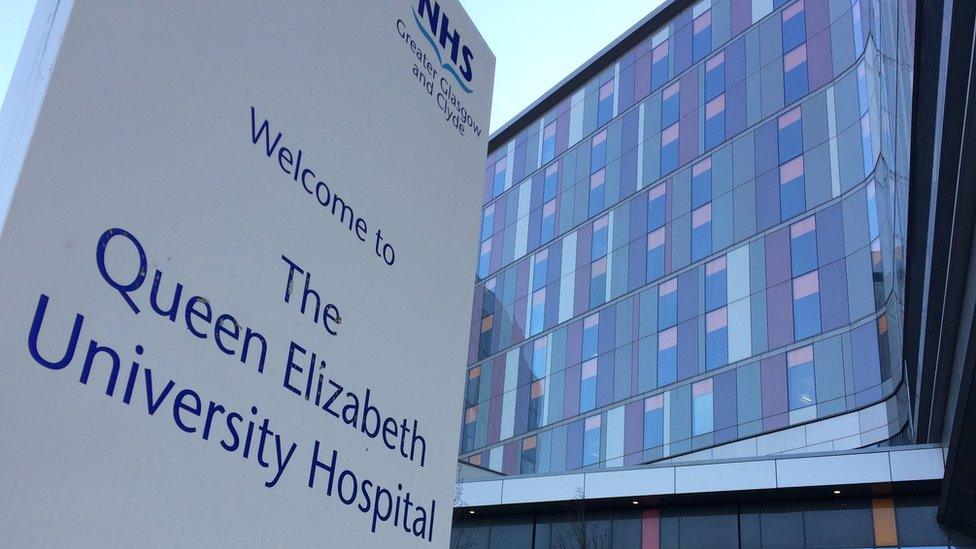Queen Elizabeth University Hospital: Inspectors raise cleanliness concerns
- Published

Some areas of Scotland's biggest hospital cannot be cleaned properly because they are awaiting repair work, a report has found.
An inspection of Glasgow's Queen Elizabeth University hospital was ordered after patients became infected with a fungus linked to pigeon faeces.
The report found 300 repair jobs were waiting to be done, but there was no evidence of a plan to complete them.
It also said the emergency department had not been properly cleaned.
This included body fluid and grime on toilet seat hinges in the reception and patient areas of the department, as well as dusty and gritty floors and blood on two patient trolleys that were ready for use.
Health Secretary Jeane Freeman told BBC Scotland it was clear from the report that NHS staff were being "let down by managers who are not acting on the issues that frontline staff are pointing out need to be addressed".
Healthcare Improvement Scotland was asked by Ms Freeman to examine cleanliness and safety at the hospital in January after the deaths of a 10-year-old boy and 73-year-old woman who had contracted cryptococcus.
In the case of the child, the bacteria was a contributory factor in his death. Although the woman was found to have the fungal infection it was not the cause of her death.
Both cases are being investigated by the Crown Office.
The cryptococcus which was found is believed to be from pigeon droppings located in a plant room on the hospital's roof.
Action plan
Separately, 23 children contracted bloodstream infections in the cancer wards at the Royal Hospital for Children - which shares the Queen Elizabeth campus - between January and September last year.
The infections were thought to be linked to bacteria in the water supply - with a report later finding "widespread contamination" at both hospitals.
NHS Greater Glasgow and Clyde (NHSGGC) has stressed that infection rates at both the Queen Elizabeth and the Royal Hospital for Children are lower than the Scottish average.
It has developed an action plan since the inspection and has pledged to address the areas of concern "as a priority".

The £842m hospital opened four years ago
In its inspection report, Healthcare Improvement Scotland said staff generally followed infection control procedures, including hand hygiene, at the 14-storey hospital - which opened in April 2015 and has 1,677 beds.
The inspectors also said infection rates at the hospital were within expected limits, but highlighted several "areas of concern" around cleanliness and infection prevention.
The report said: "During the inspection, we saw evidence that suggested significant gaps in maintenance and improvement of the care environment.
"We found a number of areas where the environment was in a poor state of repair. Estates management provided a list of at least 300 outstanding jobs without evidence of a plan to complete these.
"Where an area is damaged, this can prohibit effective cleaning".
'False assurance'
The report also said monitoring tools used at the hospital could only record whether an area such as walls or a floor had been cleaned - but not if it had been damaged, which could offer "false assurance".
Concerns were also raised about the relationship between staff and senior management, with inspectors given examples of where it was felt management had not reacted to fears about the hospital environment.
And the inspectors said they had been "made aware of some challenges in the working relationships between senior staff in the infection prevention and control team and the estates department".
The team reviewed 27 wards in the main Queen Elizabeth building, as well as the neighbouring Royal Hospital for Children and the Institute of Neurological Sciences.
Its report will help inform the Scottish government's wider independent review into the Queen Elizabeth.
NHSGGC chief executive Jane Grant said: "Patients should be assured that the prevention and control of infection has always been, and remains, a top priority for NHSGGC.
"Infection rates in the Queen Elizabeth University Hospital and the Royal Hospital for Children are low - lower than the average rate of infection in Scotland's hospitals.
"For further reassurance on infection control we asked Health Protection Scotland to carry out a detailed review of our infection performance compared to similar large hospitals over the past three years.
"Their findings confirmed that at no time during this period did infection rates at QEUH and RHC exceed expected levels."